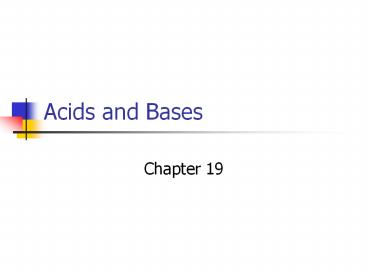Acids and Bases - PowerPoint PPT Presentation
Title:
Acids and Bases
Description:
Acids and Bases Chapter 19 Hydrolysis Cations of weak bases donate hydrogen ions leaving solutions acidic Buffer Solution in which the pH remains relatively constant ... – PowerPoint PPT presentation
Number of Views:286
Avg rating:3.0/5.0
Title: Acids and Bases
1
Acids and Bases
- Chapter 19
2
Review
- Electrolyte
- A substance that conducts an electrical current
when melted or in solution - Ionic compounds
3
Acid-Base Theories
- Different definitions of acids and bases
- Arrhenius
- Bronsted-Lowry
- Lewis
4
Arrhenius
- Acid
- Compounds that ionize to produce hydrogen ions
(H) in aqueous solutions - Examples HCl, HBr, H2SO4, CH3COOH
- Note CH3COOH is an organic acid
5
Arrhenius
- Base
- Compounds that ionize to produce hydroxide ions
(OH-) in aqueous solutions - Examples KOH, NaOH, LiOH
- Note CH3OH is not a base, its an organic
alcohol
6
Bronsted-Lowry
- Acid
- Hydrogen ion donor
- Examples HCl, HBr, H3O
- Base
- Hydrogen ion acceptor
- Examples H2O, NH3
7
Lewis
- Acid
- Accepts a pair of electrons
- Example H
- Base
- Donates a pair of electrons
- Example OH-
8
Acid-Base Theory
9
Properties of Acids
- Taste Sour
- Will change color of acid base indicator
- Can be strong or weak electrolytes in an aqueous
solution
10
Properties of Bases
- Taste Bitter
- Feel Slippery
- Will change color of acid base indicator
- Can be strong or weak electrolytes in an aqueous
solution
11
(No Transcript)
12
Ionization
- Electrolytes will dissociate into ions when
dissolved in water - Strong Electrolytes will completely dissociate
- Weak Electrolytes will only partially dissociate
13
Ionization of Water
- Water can be split into 2 ions
- H and OH-
- Ionization of Water
- H2O ? H OH-
- H2O H2O ? H3O OH-
14
Strong Acids
- Completely dissociate when in solution
- HCl(s) ? H(aq) Cl-(aq)
- HNO3(s) ? H(aq) NO3-(aq)
15
Polyprotic Acids
- Acids that have more than one H
- ExamplesH2SO4, H3PO4
- Can release more than one H into solution
- H2SO4(s) ? 2H(aq) SO42-(aq)
16
Strong Bases
- Completely dissociate when in solution
- NaOH(s) ? Na(aq) OH-(aq)
- KOH(s) ? K(aq) OH-(aq)
17
Neutral Solutions
- For neutral solutions
- H OH-
- For all aqueous solutions
- H OH- 1.0 x 10-14
18
Measuring Acidity (Alkalinity)
- Traditionally we measure H
- pH -log H
- Neutral solution H 1.0 x 10-7
- pH 7
- pOH -log OH-
- pH pOH 14
19
Acidity
- Acidic Solutions pH lt 7.0
- H gt 1.0 x 10-7
- Basic Solutions pH gt 7.0
- H lt 1.0 x 10-7
20
Changes in pH
- pH increases by 1 for every decrease in H by a
magnitude of 10
H pH
1.010-7 7
1.010-8 8
1.010-9 9
1.010-10 10
21
Measuring pH
- Litmus paper
- Red in acid
- Blue in base
- pH paper
- pH Meter
- Acid Base Indicators (Table M)
22
Table M
23
(No Transcript)
24
Neutralization
- Acid Base ? Water Salt
- Double Replacement Reaction
- HA BOH ? HOH BA
25
Neutralization
- Examples
- HCl NaOH ? H2O NaCl
- HNO3 LiOH ? H2O LiNO3
- H2SO4 2KOH ? 2 H2O K2SO4
26
(No Transcript)
27
Titration
- Process in which a volume of solution known
concentration is used to determine the
concentration of another solution - Usually shown by a color change of an indicator
(end point)
28
Titration Example
- 2 Liters of an unknown conc. of NaOH is titrated
with 1 Liter of 6M HCl, what is the concentration
of the base? - MAVA MBVB
- (6M) (1L) (X) (2L)
- X 3M NaOH
29
Polyprotic Acids
- Acids that have more than one H
- ExamplesH2SO4, H3PO4
- H2SO4 1M
- H 2M
- H3PO4 1M
- H 3M
30
Another Titration Example
- 500 milliliters of an unknown conc. of NaOH is
titrated with 1 Liter of 1M H2SO4, what is the
concentration of the base? - MAVA MBVB
- (2M) (1L) (X) (0.5L)
- X 4M NaOH
31
(No Transcript)
32
Hydrolysis
- In salt hydrolysis, cations or anions of
dissociated salts remove hydrogen ions from or
donate hydrogen ions to water
33
Hydrolysis
- Anions of weak acids remove hydrogen ions leaving
solution basic
34
Hydrolysis
- Cations of weak bases donate hydrogen ions
leaving solutions acidic
35
Buffer
- Solution in which the pH remains relatively
constant when small amounts of acid or base are
added - Solution of a weak acid and one of its salts, or
a solution of a weak base and one of its salts - H2CO3/HCO3-































